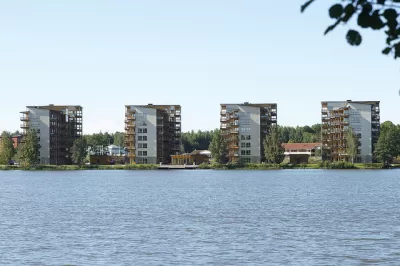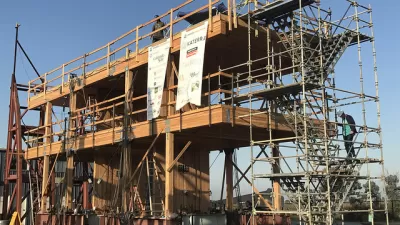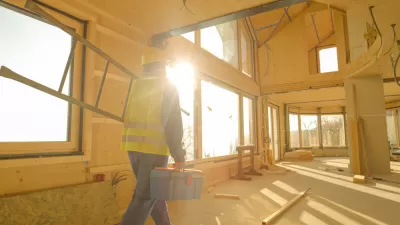Mass timber is a major structural element of an increasing number of skyscrapers, according to a CTBUH survey; now, the fire codes just have to follow.

At The Architect’s Newspaper, Matthew Messing interviews Daniel Safarik, editor of the Council on Tall Buildings and Urban Habitats (CTBUH) about its recently released global audit of “tall timber” buildings.
Tall timber refers to the use of mass timber to construct buildings that are more than seven stories; the audit follows “a spike in announcements of timber tall buildings being proposed and constructed about four years ago [2013].”
Mass timber is an “umbrella term” for several new materials (like cross-laminated timber) that make it possible to use wood to construct skyscrapers.
For reasons ranging from its potential for carbon sequestration to the possibility of local production, timber has been described as “a new frontier in low-carbon building.”
The main obstacle facing the use of tall timber is fire, both in the sense of codes it may not meet and in the sense of fears it may inspire.
The fears, Safarik says, don’t take into account the fact that these materials are produced with fire prevention in mind.
“The key to mass timber’s viability as a structural material for tall buildings lies in its name. Massive wood walls and structural beams and columns comprised of engineered panels have demonstrated fire performance equal to concrete and, in some cases, superior to steel.”
And while the “foremost obstacle” to tall timber construction is local fire codes, Safarik is confident that “[a]s more jurisdictions come to appreciate the aesthetic, economic, and environmental advantages of tall timber, fire codes are expected to change.”
The CTBUH audit lists nearly 50 tall timber designs, ranging in height from seven to 35 stories, and in geography from Lagos to Vienna to Minneapolis.
FULL STORY: Learning from the 2017 global timber tower audit

Planetizen Federal Action Tracker
A weekly monitor of how Trump’s orders and actions are impacting planners and planning in America.

San Francisco's School District Spent $105M To Build Affordable Housing for Teachers — And That's Just the Beginning
SFUSD joins a growing list of school districts using their land holdings to address housing affordability challenges faced by their own employees.

The Tiny, Adorable $7,000 Car Turning Japan Onto EVs
The single seat Mibot charges from a regular plug as quickly as an iPad, and is about half the price of an average EV.

Seattle's Plan for Adopting Driverless Cars
Equity, safety, accessibility and affordability are front of mind as the city prepares for robotaxis and other autonomous vehicles.

As Trump Phases Out FEMA, Is It Time to Flee the Floodplains?
With less federal funding available for disaster relief efforts, the need to relocate at-risk communities is more urgent than ever.

With Protected Lanes, 460% More People Commute by Bike
For those needing more ammo, more data proving what we already knew is here.
Urban Design for Planners 1: Software Tools
This six-course series explores essential urban design concepts using open source software and equips planners with the tools they need to participate fully in the urban design process.
Planning for Universal Design
Learn the tools for implementing Universal Design in planning regulations.
Smith Gee Studio
City of Charlotte
City of Camden Redevelopment Agency
City of Astoria
Transportation Research & Education Center (TREC) at Portland State University
US High Speed Rail Association
City of Camden Redevelopment Agency
Municipality of Princeton (NJ)





























